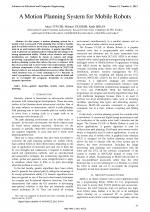| 1/2012 - 10 |
A Motion Planning System for Mobile RobotsTUNCER, A. |
| Extra paper information in |
| Click to see author's profile in |
| Download PDF |
Author keywords
genetic algorithm, mobile robot, motion planning
References keywords
robot(12), genetic(12), planning(10), path(9), mobile(8), algorithm(8), algorithms(6), robotics(5), autonomous(4)
Blue keywords are present in both the references section and the paper title.
About this article
Date of Publication: 2012-02-28
Volume 12, Issue 1, Year 2012, On page(s): 57 - 62
ISSN: 1582-7445, e-ISSN: 1844-7600
Digital Object Identifier: 10.4316/AECE.2012.01010
Web of Science Accession Number: 000301075000010
SCOPUS ID: 84860754571
Abstract
In this paper, a motion planning system for a mobile robot is proposed. Path planning tries to find a feasible path for mobile robots to move from a starting node to a target node in an environment with obstacles. A genetic algorithm is used to generate an optimal path by taking the advantage of its strong optimization ability. Mobile robot, obstacle and target localizations are realized by means of camera and image processing. A graphical user interface (GUI) is designed for the motion planning system that allows the user to interact with the robot system and to observe the robot environment. All the software components of the system are written in MATLAB that provides to use non-predefined accessories rather than the robot firmware has, to avoid confusing in C++ libraries of robot's proprietary software, to control the robot in detail and not to re-compile the programs frequently in real-time dynamic operations. |
| References | | | Cited By |
Web of Science® Times Cited: 9 [View]
View record in Web of Science® [View]
View Related Records® [View]
Updated today
SCOPUS® Times Cited: 11
View record in SCOPUS® [Free preview]
View citations in SCOPUS® [Free preview]
[1] Bio-inspired Approach for Smooth Motion Control of Wheeled Mobile Robots, Jia, Z. J., Song, Y. D., Cai, W. C., Cognitive Computation, ISSN 1866-9956, Issue 2, Volume 5, 2013.
Digital Object Identifier: 10.1007/s12559-012-9186-8 [CrossRef]
[2] Sensing pipes of a nuclear power mechanism using low-cost snake robot, Huang, Chiung-Wei, Huang, Chung-Hao, Hung, Yu-Hsiang, Chang, Cheng-Yuan, Advances in Mechanical Engineering, ISSN 1687-8132, Issue 6, Volume 10, 2018.
Digital Object Identifier: 10.1177/1687814018781286 [CrossRef]
[3] Remote Control of an Autonomous Robotic Platform Based on Eye Tracking, PASARICA, A., ANDRUSEAC, G. G., ADOCHIEI, I., ROTARIU, C., COSTIN, H., ADOCHIEI, F., Advances in Electrical and Computer Engineering, ISSN 1582-7445, Issue 4, Volume 16, 2016.
Digital Object Identifier: 10.4316/AECE.2016.04015 [CrossRef] [Full text]
[4] Design and implementation of a genetic algorithm IP core on an FPGA for path planning of mobile robots, TUNCER, Adem, YILDIRIM, Mehmet, TURKISH JOURNAL OF ELECTRICAL ENGINEERING & COMPUTER SCIENCES, ISSN 1300-0632, Issue , 2016.
Digital Object Identifier: 10.3906/elk-1502-122 [CrossRef]
[5] Navigational analysis of a humanoid using genetic algorithm with vision assistance, Kumar, Priyadarshi Biplab, Parhi, Dayal R., Multimedia Tools and Applications, ISSN 1380-7501, Issue 11-12, Volume 79, 2020.
Digital Object Identifier: 10.1007/s11042-019-08307-4 [CrossRef]
[6] Stochastic Wheel-Slip Compensation Based Robot Localization and Mapping, SIDHARTHAN, R. K., KANNAN, R., SRINIVASAN, S., BALAS, V. E., Advances in Electrical and Computer Engineering, ISSN 1582-7445, Issue 2, Volume 16, 2016.
Digital Object Identifier: 10.4316/AECE.2016.02004 [CrossRef] [Full text]
[7] Global Path Planning for Autonomous Mobile Robot Using Genetic Algorithm, Samadi, Masoud, Othman, Mohd Fauzi, 2013 International Conference on Signal-Image Technology & Internet-Based Systems, ISBN 978-1-4799-3211-5, 2013.
Digital Object Identifier: 10.1109/SITIS.2013.118 [CrossRef]
Disclaimer: All information displayed above was retrieved by using remote connections to respective databases. For the best user experience, we update all data by using background processes, and use caches in order to reduce the load on the servers we retrieve the information from. As we have no control on the availability of the database servers and sometimes the Internet connectivity may be affected, we do not guarantee the information is correct or complete. For the most accurate data, please always consult the database sites directly. Some external links require authentication or an institutional subscription.
Web of Science® is a registered trademark of Clarivate Analytics, Scopus® is a registered trademark of Elsevier B.V., other product names, company names, brand names, trademarks and logos are the property of their respective owners.
Faculty of Electrical Engineering and Computer Science
Stefan cel Mare University of Suceava, Romania
All rights reserved: Advances in Electrical and Computer Engineering is a registered trademark of the Stefan cel Mare University of Suceava. No part of this publication may be reproduced, stored in a retrieval system, photocopied, recorded or archived, without the written permission from the Editor. When authors submit their papers for publication, they agree that the copyright for their article be transferred to the Faculty of Electrical Engineering and Computer Science, Stefan cel Mare University of Suceava, Romania, if and only if the articles are accepted for publication. The copyright covers the exclusive rights to reproduce and distribute the article, including reprints and translations.
Permission for other use: The copyright owner's consent does not extend to copying for general distribution, for promotion, for creating new works, or for resale. Specific written permission must be obtained from the Editor for such copying. Direct linking to files hosted on this website is strictly prohibited.
Disclaimer: Whilst every effort is made by the publishers and editorial board to see that no inaccurate or misleading data, opinions or statements appear in this journal, they wish to make it clear that all information and opinions formulated in the articles, as well as linguistic accuracy, are the sole responsibility of the author.



